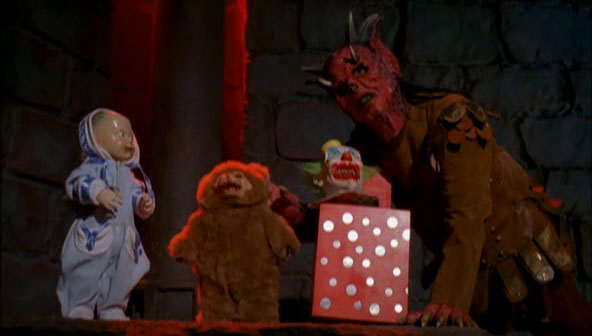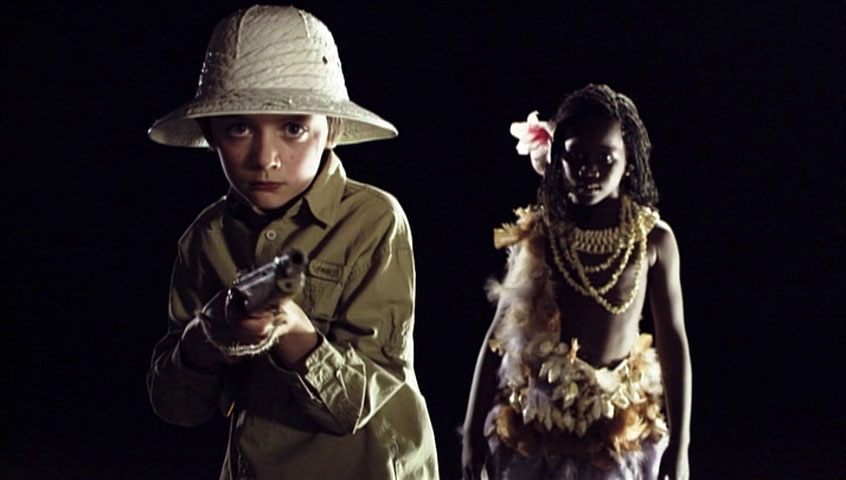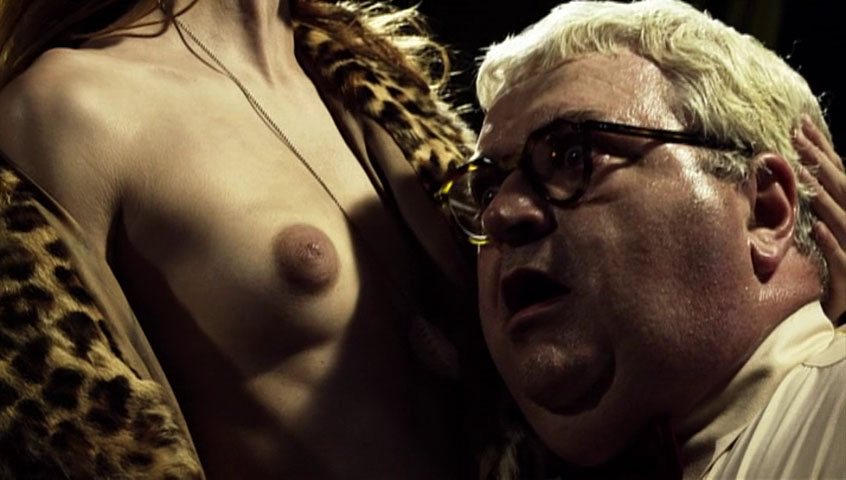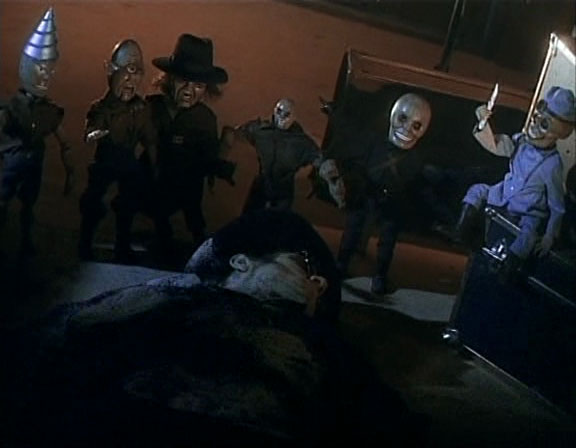Going through some animation and avant-garde DVDs on a Saturday afternoon, looking for shorts I’ve never seen before… time well spent.
–
Cinq minutes de cinema pure (1926, Henri Chomette)
Silent light shines on glassy objects… spinning and cross-fading, never lingering more than a few seconds on each pattern. We go unexpectedly outside to a forest and pond with blown-out white skies in the final minute. It’s pure cinema, I suppose. Chomette was René Clair’s brother.

–
Dots (1940, Norman McLaren)
Hand-drawn on 35mm (including the soundtrack!), a rhythmic dance of blue dots on a red field, short and very fun.

–
Mail Early (1941, Norman McLaren)
Public service announcement to not wait till the last minute to send your Christmas mail, via lively hand-drawn envelopes flying across screen to a jazzy Jingle Bells.

–
Mail Early for Christmas (1959, Norman McLaren)
The remake is shorter and crazier, all flashing light and pattern (etched on film with “vibra-drill”), the title message coming through in single-frame flickers.

–
Lines Vertical (1960, Norman McLaren)
The line pongs left and right, multiplying again and again until the background color field starts to shift as the line-dance gets more complex. Various optical illusions: imagining the filmstrip flying upwards is easy with this short, and at a few points the lines’ relative thickness with their back-and-forth motion gives the impression of cylindrical columns. Music sounds like electric harp emulating wind chimes and is very soothing.
The lines definitely get un-vertical at the end:

–
Mosaic (1965, Norman McLaren)
Lines Horizontal is literally Lines Vertical turned on its side, so I skipped to Mosaic, whiich is the two of them superimposed and processed somehow. I was expecting a shifting line grid, but I got dots, maybe the vertices of the intersecting lines. More sputtering hand-drawn sounds (now with added reverb), the white dots flickering to color in brief spots.

–
Two Greedy Bear Cubs (1954, Vladimir Degtyaryov)
Early post-Stalin film from the first History of Soviet Puppet Animation DVD. Bright fairy-tale stop-motion puppetry about two sibling bears who promise to share equally, but fight over the bedding and over their breakfast, then when they find a gigantic block of cheese they can’t figure how to split it equally until a helpful fox comes to help, creating unequal sides, then biting chunks off the larger piece each time the whiny bears complain about their smaller share, until the bears are left with crumbs.

–
Kolobok (1956, Roman Davydov)
Love the look of this one, like the wooden incense-smoking figurines my family used to collect. Six decades before Pixar’s Bao, a childless couple bakes a gingerbread bun and it comes to life. The bun romps through the fields and woods, taunting the bear and wolf while singing a happy song about how delicious it must be, until a fox (again with the foxes) chases it to safety at home where it lives happily with its family.

–
How to Kiss (1988, Bill Plympton)
A classic example of Plympton finding a multitude of ways to turn something lovely into ghastly images. Our lovers end up dead or mutilated many times over – practically a horror movie.

–
Nosehair (1995, Bill Plympton)
Man struggles to remove a nosehair, and I thought this would end up like Wisdom Teeth, but it goes in remarkable new directions, too many to describe. The hair turns into a line, and for a while the movie becomes a riff on all things animators can create from simple lines. Can’t believe I’d never seen this, it’s one of his greats.

–
Aria (2001, Pjotr Sapegin)
You know it’s classy from the opera music, but it also opens with some explicit puppet sex. After a fling with a sailor, the Island Woman gives birth… and never cuts the cord, so she and her daughter fly each other like kites. That is not even nearly the craziest thing that happens, for when the sailor and his Barbie wife come to take the child away, the woman undoes herself, down to her puppet armature and beyond, some 14 years before Anomalisa.

–
The Dingles (1988, Les Drew)
Gentle, over-narrated kids’ cartoon about a woman and her three cats who experience a minor drama when a thunderstorm arrives.

–
The Magic Pear Tree (1968, Charles Swenson)
A Decameron story. Jean visits the Marquis, he makes her prove her love with difficult tasks before he’ll have sex with her. A cheap-looking silly-ass movie, so of course it’s oscar-nominated. Swenson later wrote Fievel Goes West and produced Rugrats, Jimmy Murakami produced, and the overqualified voice cast includes Agnes Moorhead (Citizen Kane) and Keenan Wynn (Dr. Strangelove).

–
Hell’s Bells (1929, Ub Iwerks)
You don’t expect a Disney cartoon to take place in hell. Betty Boop-lite antics as demons and bats dance and transform to the music. The Silly Symphonies tend to seem more like a bit of fun than anything of great interest… time-filler content before the feature. Carl Stalling, however – I hope he died a billionaire.

–
Projekt (1981, Jirà Barta)
Apartment building is drafted in stop-motion, then furnishings and residents are added, each with their own art style and soundtrack, until all the soundtracks are playing at once, then the architect runs a roller over the building until everything is colorlessly conformist again. Pretty great.

–
Ballad of the Green Wood (1983, Jirà Barta)
Now beyond paper and ink, he’s animating light, wood and water, mud, worms and plants. An anthropomorphic piece of split wood is eaten by a crow, who becomes part wood, transforming into a wood-demon crow-bat harbinger of winter, until a wooden soldier arrives and slays him to bring back the spring. I think from the art style that it might represent Christians burning pagans? It brought to mind Hannah Gadsby‘s “am I made of box?” and also was amazing in every way – I’ve seen Jirà Barta’s name around before, and now I must see everything.

–
When the Leaves Have Fallen from the Oak (1991, Vlasta Pospisilova)
A long one, almost a half hour. Superb puppet animation, very talky and unsubtitled, but I usually knew what’s going on. Devil arrives in a whirlwind to a drunken failure of a farmer, will give him magic contraptions to make the farm thrive if he only signs a contract surrendering his firstborn. The farmer attempts suicide when collection time is near and… an old man hears his story then rolls around in honey and feathers? Anyway the farmer ends up in hell himself, running a daily routine of freezing / boiling / hard labor / drinking, until he breaks the cycle by refusing to drink anymore. Another devil contract to bring the farm back to life, this time he fools the devil by promising something when the leaves of an evergreen begin to fall… surprised it’s so easy to fool the devil, but it’s nice to see things work out for once. Vlasta also did animation for directors such as Kihachiro Kawamoto and Jan Svankmajer.


–
Is The Earth Round? (1977, Priit Pärn)
A boy reads that you can prove the earth is round by walking in one direction until you end up where you started – so he does, but arrives home as an old man. Appreciate the seventies freakout rock & roll, and when his empty pockets become wings and fly him out of the city.

–
Hotell E (1992, Priit Pärn)
I did not even nearly follow the metaphors here. After a couple of prologues, the movie splits between two worlds: a clock-driven monochrome fly-infested hellscape, and a music-video new-age dreamscape, each mirroring one of the prologues. There’s a door, and they begin to intersect. Movie goes on for ages, always repeating actions but always in new variations. It seems angry.




























































